Monday, April 25, 2005
Nashbar, sport touring [NFS]
Digital Gallery: Each of the following thumbnails will open a 300x225 ~200KB pix by clicking in the upper LH corner, or a 640x480 ~300KB pix by clicking the image in the lower RH corner …Firefox will open the image in a small popup window, a new tab, or a new window (it depends upon your settings and extensions), and you can leave the popup open to view other detail photos (of the same size) …IE will usually open a popup window, or it may just open the link (and you’ll have to to manually return to this page). As usual, popup windows have to be closed manually. I’ve no idea how the links might work (or not) in other browsers (or earlier versions of IE than 5.5SP2), but if you notice something weird, let me know (in the post Comments) and I’ll try to fix it.
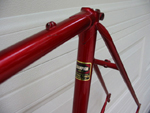 | 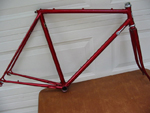 | 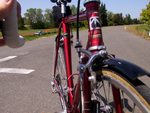 |
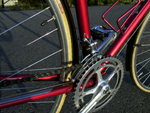 | 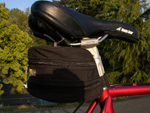 | 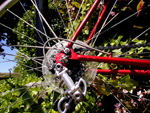 |
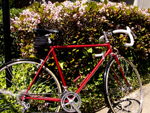 | 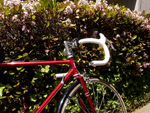 | 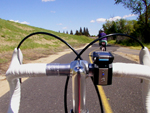 |
Description: This is an early-1980’s Japanese manufactured Nashbar frame & fork, that I purchased for only $9.95 (from an iBOB list member). And as it was shipped within the same box as a Panasonic PT-3500 touring F&F (purchased at the same time, and which frameset is also in the Photo Gallery), there was no additional cost for its shipping. (Yep: $10 total. Cool.)
The frame has DT braze-
Wheels are built on rather narrow Super Champion (Gentleman) 36H rims w/eyelets (fr & rr), 3-
This was a project bike that ended up turning into my favoured choice for fast day rides …one of those rare occasions when everything fit me to a “T”, and the parts all worked exceptionally well together (though I’m quite opinionated about this subject area …oddly enough, these same parts — mostly — did not “work well” on the Mercian). It’s a real pleasure to ride.
Components: I built-
Dimensions: Note that standover height is measured from the ground to top of top tube with fully inflated (100psi) 622x19 (700C) tyres. Disclaimer — all dimensions are to the “best of my ability” measurements and so you should consider them at best only “approximately accurate” (I try, but I have to “eyeball” some things). If you require more — or other — details, let me know.
| TT (c-c): | 21½", 55cm | Standover: | 30¼", 77cm | |||
| ST (c-c): | 20½", 52cm | Width fr: | 100mm | |||
| ST (c-t): | 21¼", 54cm | Width rr: | 122mm | |||
| Wheelbase: | 38¾", 99cm | BB width: | 68mm | |||
| BB to DO: | 161/8", 41cm | BB thread: | BSC | |||
| Trail: | 1¾", 4.5cm | BB height: | 10", 25.4cm | |||
| ST angle: | 73° | Bar width: | 15", 38cm | |||
| HT angle: | 74° | Bar drop: | 6¼", 16cm | |||
| SP: | 27.0mm | Stem: | 8cm |
Gears: My preference for determining optimal shifting is to use an inch gearing chart of the chainwheels and cogs …the name “inch gear” is based upon the size of the front wheel of the old “ordinary” bicycles of the 1890’s: each number in the chart corresponds to the diameter of a wheel of that size (a 72 inch gear would correspond to a 72 inch diameter wheel size).
The top row of the chart is the number of teeth in the chainrings (inner across to outer, or smallest chainring across to largest chainring); the left column of the chart is the number of teeth of the rear cog (also inner down to outer, or largest cog down to smallest cog) …it may seem counter-intuitive, but the small front ring coupled to the large rear cog results in the lowest gear of a multi-speed derailleur bicycle; while the large front and small rear results in the largest gear. You can determine the distance traveled in a single turn of the cranks by multiplying the inch gear times π (π=3.1416).
The suggested (half-
| 42 | 47 | |
| 25 | 45 | 51 |
|---|---|---|
| 21 | 54 | 59 |
| 17 | 67 | 75 |
| 15 | 76 | 85 |
| 14 | 81 | 91 |
Impressions: The finish is far from pristine; but though the frameset has obviously seen lots of use through the years, it hasn’t suffered any visible damage or abuse. Plenty of paint chips (rather noticeably touched-up), but no dents, and no rust. Straight. Exceptionally stable; steers well hands-off for as long as you’d probably care to ride it sans hands. The narrow leather-covered alloy gel saddle is surprisingly comfortable for less then 40 mile day rides. The criterium style bars are deep drop, and allow for the low riding positions so handy for boring into a direct or quartering wind. Umm, the brakes are typical vintage Records (oh y’know, euphemistically “gentle” stoppers …they do work, eventually …by exerting rather more lever pressure then is fashionable these days …I s’pose I really should rewrap the bars and change the lever position …it might help). For vintage NR derailleurs, shifting is quite crisp, though of course dependent upon the degree of your remaining skills with friction gear; the reward is the gratifying snick-click of a well-executed shift that is such music to the ears of us retro-grouches.The tyres are 19’s …and with the mudguards, I don’t think it would be such a great idea to go more then 23’s (which is okay with me for this bike, as the its purpose is for day-
Search Terms: Nashbar, vintage bicycle, classic bicycle, Campagnolo, Campy, NR, Nouvo Record, Ambrosio, Super Champion, Shimano, Planet Bike, Sakae, SR, Suntour, Sun Tour, lugs, lugged, doublebutted, double butted, cromoly, chrome molybdenum, sport touring


